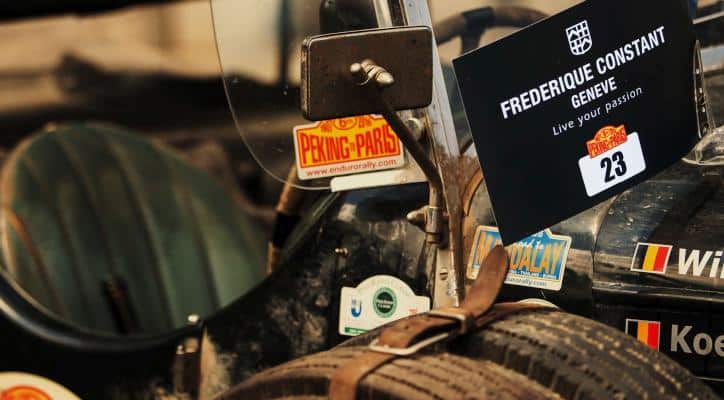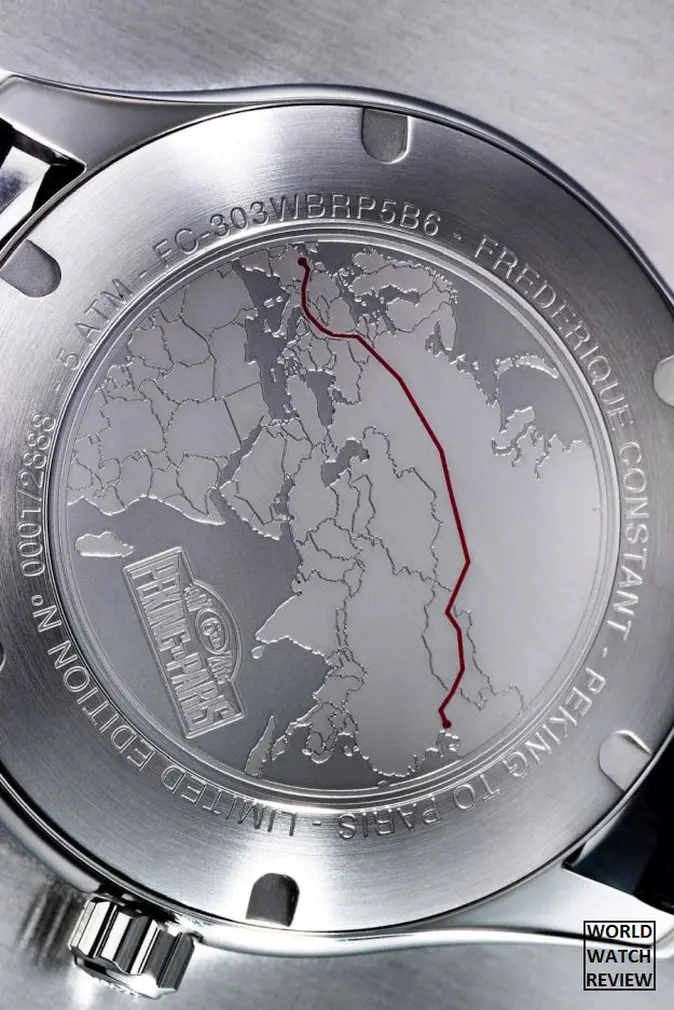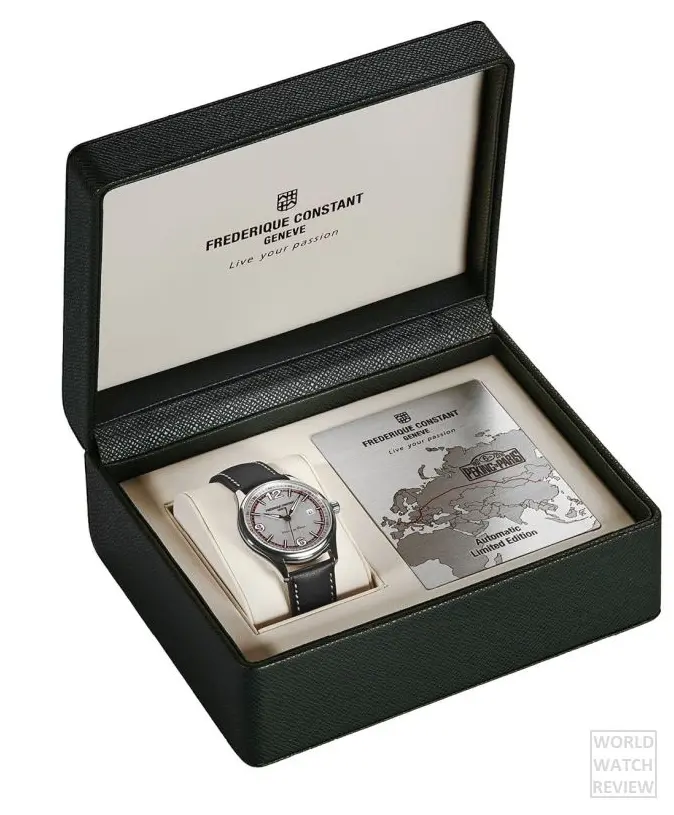
The 2016 limited-edition Frederique Constant Peking to Paris (ref. FC-303WBRP5B6) may not be revolutionary or groundbreaking in any meaning of the words, but it is still an interesting (albeit a tad overpriced) timekeeper for a person interested in a nice three-hander with a just a grain of sportiness to it. While the “limited edition” part may be a bit gimmicky (in a sense that you can’t seriously expect a piece limited to almost 2900 units to become a rarity in any foreseeable future,) all the rest is legit: it is an expertly designed, solidly built piece that is powered by a robust mechanism.
Overall Impression
I frankly can’t say that the news of Frederique Constant, its sister brand Alpina, and their younger sibling Ateliers deMonaco being acquired by the Japanese Citizen Holdings Co., Ltd. shook me, but I must admit that I was sort of disappointed by the development. With the group of brands showing signs of tremendous progress in developing their own identity, while introducing a bunch of good in-house movements, and probably gathering their flock of faithful fans, yours truly hoped to soon witness the arrival of yet another major player that would someday be able to compete (well, maybe just in particular niches at first) with such giants as the Swatch Group and Richemont SA.

To my regret, it didn’t happen. Turns out, the brands’ founders were simply looking for a successful exit strategy that would allow them to gracefully bow out of the declining market. Well, maybe there were other reasons, too, but that’s not important right now: the brands are well established and there is still a good chance that their new Japanese owner will continue pushing them in the direction chosen by the founders.
Of course, this new Peking to Paris (ref. FC-303WBRP5B6) doesn’t look terribly original and, being a version of their relatively fresh Vintage collection watches, new (and it doesn’t look like FC’s swan song either,) but it is still a nice accessory that deserves some of your attention.
Case & Strap
At 40 millimeters in diameter, the case is compact by today’s standards, but I can’t call it ‘small’: with its relatively long lugs, it takes almost all the width of a normal wrist and, being relatively thick, has that sporty presence that we tend to expect from a product inspired by the roaring world of motorsports.

As far as the ergonomics are concerned, the notched crown at 3 o’clock looks large enough to be convenient even to persons with stubby fingers, although I would probably prefer it to be just a hair shorter.
The case back cover is predictably crafted from solid steel and is engraved with the map of Peking to Paris Vintage Rally with the route itself represented by a Burgundy red line (you will see during the course of this review that there are a lot of small splashes of Burgundy red in this watch, although I feel obliged to say right away that the use of the accent color is always prudent, discreet and tasteful, too.)
Of course, it would probably be more interesting if the map was laser-engraved on a tinted sapphire glass or something like that, but that would have also dramatically increased the cost while making a deep dent in the brand’s expected profit margin.
The dark grey strap is soft and comfortable and, featuring burgundy red contrast stitching that is echoed by elements of the same color on the dial and the case back cover, looks classy enough for this watch. It comes with a stainless steel buckle that adds more, um, authenticity to this timekeeper, although some people may find it not particularly convenient. I would probably change it immediately for something better (like, say, a nice perforated leather strap with good water-resistant padding and secure deployment clasp,) but that’s my personal preference, not something that needs to be done right away while increasing the cost.
The timekeeper will arrive in a nice presentation box (see below) that, too, features something that looks like an aluminum plaque with the same Vintage Rally map and all the usual branding that comes with it.
Dial
It is the dial where the watch truly -although not literally- shines.
As you can see, the silvered dial features sandblasted texture and is decorated with nine hour-markers and three Arabic numerals that, too, are hand-applied to the face. Hand-polished and painted “pearl black,” all elements are covered with thick layers of Superluminova that ensure the gadget’s nighttime readability.
The same goes for the hour and minute hands that come in the same elegant shape as those on some other members of their modern range (like, say, the last year’s Vintage Rally Healey Chronograph as well as the beautiful 2014 Runabout Chronograph collection,) although the deep black color makes them look even more refined than usual.
The dial seems to be composed of two parts with the outer ring acting as a minute scale, while the chapter ring on the outer edge of the central disk is nicely decorated with a Burgundy red chapter ring with an extra 1/5th of a second scale. Although kind of superficial, the scale with its nod to vintage stopwatches makes the dial of the piece even more entertaining to look at.
Unlike many mildly oversized watches with standard-issue mechanisms (see below,) this one plays nicely with the problem of date aperture that has to be placed pretty far from the bezel flange. The Burgundy-colored chapter ring (it, by the way, matched by a relatively small italicized Paris to Peking inscription in the lower half of the face) serves as a sort of filler between the slightly elevated outer disk and the calendar window making the part to look almost perfectly in place while nicely balancing out the large “9” digit on the left.
I must admit that I am looking at the dial right now and just can’t find any noticeable flaw in it: it is well-balanced, looks original, uses a high-contrast color scheme that makes the dial readable in daylight, and features lots of lume that make it legible enough both in twilight and in total darkness. The face looks like an evolution of an already successful design that, luckily for us, goes in the right direction (you all know how sometimes a good design is spoiled in a hasty attempt to make it look “fresh”.)

I think, for this review, I’d give it five stars out of five both in the “originality” and “legibility” departments. Hell, I think I’d give it five stars when it comes to usability, too, since I can’t imagine how you can make it even more usable. Well, a fast date correction pusher would be nice, but that’d require a different movement, and, from where I stand, even the lack of the pusher doesn’t seem to be a usability problem at all.
Mechanism
It’s been more than eight years that yours truly has been writing reviews for this blog and, suddenly, he (I mean, I) starts to realize that movements are perhaps the least interesting part of any write-up regarding most timekeepers in this price range. As a general rule, the great majority of watchmakers tend to equip their timekeepers with mass-produced mechanisms sourced either from ETA or from their competitors that usually simply replicate the design of the most popular blank calibers of the post Quartz Crises era with minor modifications to avoid lawsuits.
There are always exceptions to the rule with limited editions that are animated by NOS calibers that were manufactured right after World War II by now-extinct brands and, for some reason, weren’t sold out to the highest bidder when a certain maison went bust. And, of course, there are aspiring brands who dare to invest a great deal of money into either designing their movements from scratch or even buying a Swiss-based specialist that already has a caliber, but can’t get into the crowded market on its own.
Frederique Constant has at least one in-house movement in its stable (namely, the Caliber FC-703 that powered their beautiful 2015 Slimline Moonphase Manufacture Ladies) but, for some reason, decided to go with a time-proven Sellita SW200-1 ebauche (earlier models were based on ETA 2824-2, but that’s no longer the case) that they prefer to call Caliber FC-303 for marketing purposes.

As I have mentioned, probably more than once, the movement is boring, but in a good way. It is reliable and robust, its daily accuracy is satisfactory (although sometimes the mechanisms still need to be properly regulated right out of the box, that’s not that often,) and they, like any good mechanism, don’t usually need any more attention than a scheduled change of oil and demagnetization in case you happen to work or live in an environment with reasonably strong magnetic fields.
So, again, this is a good workhorse movement. Not great, not unique: just good. It is a movement that, being a buyer of a relatively affordable timekeeper who probably wants to get maximum mileage out of it, while minimizing its cost of ownership, you actually want to power your watch.
Pricing & Availability
The collection is listed as a “limited edition,” but, with a total production run of 2888 pieces, this looks like a sort of gimmick to me: with so many watches to be manufactured, you can’t expect it to become a rarity any time soon and it will certainly not going to start appreciating in any foreseeable future.
More than that, I already see the watch being offered at certain online stores with discounts of up to 36 percent off the minimum $1595 price suggested by the manufacturer, which means, that you will have to compete with guys who bought one from reputable online stores like Jomashop and the like, so, if you buy one at MSRP, you are going to lose a lot of cash while trying to sell the piece if your honeymoon with it doesn’t last as long as you have initially expected.
So, beware of the MSRP and try to negotiate a good discount: even at a base price of $1595, it is considerably overpriced.
WWR Verdict
Originality 5/5
Build Quality: 5/5
Usability: 5/5
Overall Legibility: 4.5/5
Nighttime Legibility: 4.5/5
Value for Money: 3.5/5
Overall Rating: 4.5/5
See also: Frederique Constant Carrera Panamericana Edition (FC-435S6B6 & FC-435V6B6)
Photos: Frederique Constant
Frederique Constant Peking to Paris (ref. FC-303WBRP5B6) specification
Price: $1595 (MSRP)
Winding: Automatic
Movement: Caliber FC-303 (base Sellita SW200-1), Swiss Made
Number of jewels: 26
Movement frequency: 28,800
Power reserve: 38 hours
Functions: Hours, minutes, central seconds, date
Case: Stainless steel
Shape: Round
Size: 40.00 mm
Dial: Silvered, sand-blasted
Numerals: Arabic, applied, luminous
Hour markers: Applied, luminous
Hands: Black Pearl, luminous
Water resistance: 50 meters
Strap: Dark grey soft leather strap with burgundy red contrast stitching, steel pin buckle
Crystal: Sapphire, convex, antireflective coating
Back: Solid, engraved
